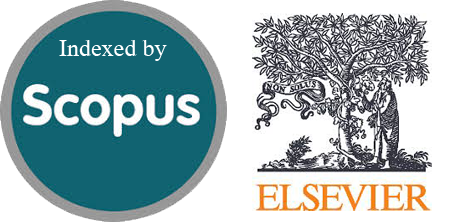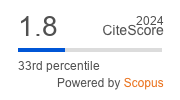Iris Recognition Using Hybrid Self-Organizing Map Classifier and Daugman’s Algorithm
Abstract
One of the neural network algorithms that can be used in iris recognition is self-organizing map (SOM). This algorithm has a weakness in determining the initial weight of the network, which is generally carried out randomly, which can result in a decrease in accuracy when an incorrect determination is made. The solution that is often used is to apply a hybrid process in determining the initial weight of the SOM network. This study takes an approach using the cosine similarity equation to determine the initial weight of the network SOM in order to increase recognition accuracy. In addition, the localization process needs to be carried out to limit the area of the iris image being studied so that it is easy for the recognition process to be carried out. The method proposed in this study for iris recognition, namely hybrid SOM and Daugman’s algorithm, has been tested on several people by capturing the iris of the eye using a digital camera. The captured eyes have been localized first using the Daugman’s algorithm, and then the image features were extracted using the GLCM and LBP methods. In the final stage of the study, an iris recognition comparison test was performed, and the results obtained an accuracy of 85.50% using the proposed method and an accuracy of 73.50% without performing a hybrid process on the SOM network.
Downloads
References
A. Sharma, P. Chaturvedi, and S. Arya, “Human Recognition Methods based on Biometric Technologies,” Int. J. Comput. Appl. (0975 – 8887), vol. 120, no. 17, pp. 1–7, 2015, https://doi.org/10.5120/21316-4312.
A. Matin, F. Mahmud, S. T. Zuhori, and B. Sen, “Human iris as a biometric for identity verification,” ICECTE 2016 - 2nd Int. Conf. Electr. Comput. Telecommun. Eng., no. December, 2017, https://doi.org/10.1109/ICECTE.2016.7879610.
I. M. Alsaadi, “Physiological Biometric Authentication Systems Advantages Disadvantages And Future Development A Review,” Int. J. Sci. Technol. Res., vol. 4, no. 12, pp. 285–289, 2015, http://www.ijstr.org/final-print/dec2015/Physiological-Biometric-Authentication-Systems-Advantages-Disadvantages-And-Future-Development-A-Review.pdf.
M. Dua, R. Gupta, M. Khari, and R. G. Crespo, “Biometric iris recognition using radial basis function neural network,” Soft Comput., vol. 23, no. 22, pp. 11801–11815, 2019, https://doi.org/10.1007/s00500-018-03731-4.
K. Hajari, U. Gawande, and Y. Golhar, “Neural Network Approach to Iris Recognition in Noisy Environment,” Phys. Procedia, vol. 78, no. December 2015, pp. 675–682, 2016, https://doi.org/10.1016/j.procs.2016.02.116.
S. Askari and H. R. Sahebi, “A Novel Method for Iris Recognition Using BP Neural Network and Parallel Computing,” ACSIJ Adv. Comput. Sci. an Int. J., vol. 5, no. 2, pp. 1–6, 2016, https://civilica.com/doc/793688/.
S. Sondhi, “IRIS Pattern Recognition Using Self-Organizing Neural Networks,” IJCA Proc. Natl. Conf. Adv. Electron. Telecommun. Eng., vol. 2012, no. iv, pp. 12–17, 2012, https://www.ijcaonline.org/proceedings/ncaete/number1/6589-1079.
C. Wang, Y. Zhu, Y. Liu, R. He, and Z. Sun, “Joint Iris Segmentation and Localization Using Deep Multi-task Learning Framework,” ArXiv Comput. Vis. Pattern Recognit., pp. 1–13, 2019, https://doi.org/10.48550/arXiv.1901.11195.
R. Tobji, W. Di, and N. Ayoub, “FMnet: Iris segmentation and recognition by using fully and multi-scale CNN for biometric security,” Appl. Sci., vol. 9, no. 10, pp. 1–17, 2019, https://doi.org/10.3390/app9102042.
R. Chaturvedi and Y. S. Thakur, “Iris Recognition using Daugman’s Algorithm and ANN,” Int. J. Appl. Eng. Res., vol. 14, no. 21, pp. 3987–3995, 2019, https://www.ripublication.com/ijaer19/ijaerv14n21_04.pdf.
A. Ben-Hdech, Y. Ghanou, and A. El Qadi, “A new algorithm for optimizing the self-organizing map,” J. Theor. Appl. Inf. Technol., vol. 78, no. 3, pp. 415–420, 2015, http://www.jatit.org/volumes/Vol78No3/10Vol78No3.pdf.
A. Ahmad, R. Yusoff, M. N. Ismail, and N. R. Rosli, “Clustering the imbalanced datasets using modified Kohonen self-organizing map (KSOM),” Proc. Comput. Conf. 2017, vol. 2018-Janua, no. July, pp. 751–755, 2018, https://doi.org/10.1109/SAI.2017.8252180.
H. Lin and Z. Ji, “Breast Cancer Prediction Based on K-Means and SOM Hybrid Algorithm,” J. Phys. Conf. Ser., vol. 1624, no. 4, 2020, https://doi.org/10.1088/1742-6596/1624/4/042012.
J. J. Winston, G. F. Turker, U. Kose, and D. J. Hemanth, “Novel optimization based hybrid self-organizing map classifiers for iris image recognition,” Int. J. Comput. Intell. Syst., vol. 13, no. 1, pp. 1048–1058, 2020, https://doi.org/10.2991/ijcis.d.200721.001.
G. M. Xian, “An identification method of malignant and benign liver tumors from ultrasonography based on GLCM texture features and fuzzy SVM,” Expert Syst. Appl., vol. 37, no. 10, pp. 6737–6741, 2010, https://doi.org/10.1016/j.eswa.2010.02.067.
X. Zhang and W. Wang, “Finger vein recognition method based on GLCM-HOG and SVM,” Proc. 2020 IEEE 3rd Int. Conf. Inf. Syst. Comput. Aided Educ. ICISCAE 2020, pp. 698–701, 2020, https://doi.org/10.1109/ICISCAE51034.2020.9236798.
M. Yogeshwari and G. Thailambal, “Automatic feature extraction and detection of plant leaf disease using GLCM features and convolutional neural networks,” Mater. Today Proc., no. xxxx, 2021, https://doi.org/10.1016/j.matpr.2021.03.700.
A. Unni, N. Eg, S. Vinod, and L. S. Nair, “Tumour Detection in Double Threshold Segmented Mammograms Using Optimized GLCM Features fed SVM,” 2018 Int. Conf. Adv. Comput. Commun. Informatics, ICACCI 2018, pp. 554–559, 2018, https://doi.org/10.1109/ICACCI.2018.8554738.
Q. Zhang, “Facial expression recognition in VGG network based on LBP feature extraction,” Proc. - 2020 5th Int. Conf. Mech. Control Comput. Eng. ICMCCE 2020, pp. 2089–2092, 2020, https://doi.org/10.1109/ICMCCE51767.2020.00454.
Y. X. Zhang, Y. Q. Zhao, Y. Liu, L. Q. Jiang, and Z. W. Chen, “Identification of wood defects based on LBP features,” Chinese Control Conf. CCC, vol. 2016-Augus, pp. 4202–4205, 2016, https://doi.org/10.1109/ChiCC.2016.7554010.
L. Zhang, B. Zhong, and A. Yang, “Building Change Detection using Object-Oriented LBP Feature Map in Very High Spatial Resolution Imagery,” 2019 10th Int. Work. Anal. Multitemporal Remote Sens. Images, MultiTemp 2019, pp. 1–4, 2019, https://doi.org/10.1109/Multi-Temp.2019.8866919.
S. Al-Otaibi et al., “Cosine similarity-based algorithm for social networking recommendation,” Int. J. Electr. Comput. Eng., vol. 12, no. 2, pp. 1881–1892, 2022, https://doi.org/10.11591/ijece.v12i2.pp1881-1892.
W. S. J. Saputra, C. A. Putra, and Y. V. Via, “Unsupervised Image Segmentation Algorithm using Superpixel and Cosine Similarity,” Int. Conf. Sci. Technol. (ICST 2018), vol. 1, no. Icst, pp. 9–13, 2018, https://doi.org/10.2991/icst-18.2018.3.
E. Laoh, F. Agustriwan, C. Megawati, and I. Surjandari, “Internet Traffic Forecasting Model using Self Organizing Map and Support Vector Regression Method,” Makara J. Technol., vol. 22, no. 2, p. 60, 2018, https://doi.org/10.7454/mst.v22i2.3351.
S. Lakshminarayanan, “Application of Self-Organizing Maps on Time Series Data for identifying interpretable Driving Manoeuvres,” Eur. Transp. Res. Rev., vol. 12, no. 1, 2020, https://doi.org/10.1186/s12544-020-00421-x.
Y. Sari, M. Alkaff, and R. A. Pramunendar, “Iris recognition based on distance similarity and PCA,” AIP Conf. Proc., vol. 1977, no. June 2018, 2018, https://doi.org/10.1063/1.5042900.
A. S. Shirkhorshidi, S. Aghabozorgi, and T. Ying Wah, “A Comparison study on similarity and dissimilarity measures in clustering continuous data,” PLoS One, vol. 10, no. 12, pp. 1–20, 2015, https://doi.org/10.1371/journal.pone.0144059.
K. Zuva and T. Zuva, “Effectiveness of Image ( dis ) similarity Algorithms on Content- Based Image Retrieval,” Res. Inven. Int. J. Eng. Sci., vol. 1, no. 1, pp. 31–35, 2012, http://www.researchinventy.com/papers/v1i1/E011031035.pdf.
Copyright (c) 2023 Jurnal RESTI (Rekayasa Sistem dan Teknologi Informasi)

This work is licensed under a Creative Commons Attribution 4.0 International License.
Copyright in each article belongs to the author
- The author acknowledges that the RESTI Journal (System Engineering and Information Technology) is the first publisher to publish with a license Creative Commons Attribution 4.0 International License.
- Authors can enter writing separately, arrange the non-exclusive distribution of manuscripts that have been published in this journal into other versions (eg sent to the author's institutional repository, publication in a book, etc.), by acknowledging that the manuscript has been published for the first time in the RESTI (Rekayasa Sistem dan Teknologi Informasi) journal ;








